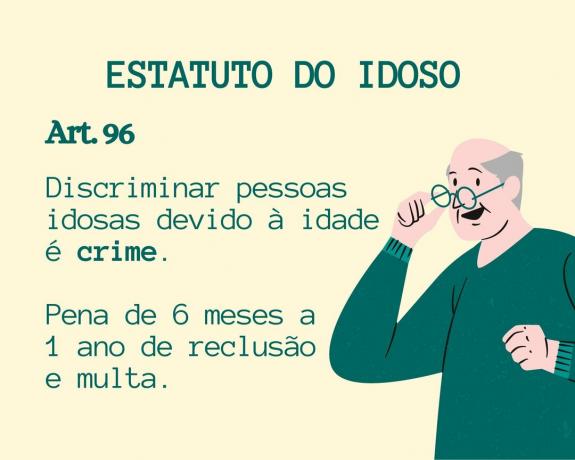Ageism is the discrimination due to age. It is generally aimed at old people, but it can be any type of prejudice based on age group, whether for children, young people or older people.
Ageism harms the self-esteem and emotional well-being of victims, and can even prevent them from having access to work, study, leisure opportunities, among others.
Saying that a person is not old enough to do a certain activity or even saying that someone is doing very well for their age are examples of ageism.
Excluding young or older people from job offers because of their age is also an example of discrimination. In Brazil, the ageism is a crime. Article 96 of the Elderly Statute states that it is a crime:
Discriminate elderly people, preventing or hindering their access to banking operations, means of transport, right to contract or by any other means or instrument necessary for the exercise of citizenship, for reasons of age.
For those who commit the crime of discrimination, the penalty ranges from six months to one year in prison plus payment of a fine. If the crime is committed by the caregiver or person responsible for the elderly person, the penalty increases by one third.
Although the victims of ageism can be of any age, the elderly are those who suffer the most discrimination due to their age.

Ageism in Brazil
The elderly population in Brazil has grown in recent decades, due to an increase in quality of life and consequently greater longevity. In addition to living longer, people are also staying active longer.
The Census, carried out by the Brazilian Institute of Geography and Statistics (IBGE) in 2022, showed that around 32 million people are over 60 years old in the country.
Although the elderly population has increased, ageism has not decreased in the country, and the issue has even gained more political and social visibility recently.
The Brazilian social imaginary still believes that some behaviors or attitudes are not appropriate for older people, whether using a certain type of clothing or haircut, going to bars, nightclubs and shows, going out alone, studying, working in some professions or taking on job positions leadership.
Brazilian elderly people face prejudice in their everyday relationships and also when looking for work or study. There are people qualified for roles, but who are not hired based on their age.
Ageism in Brazil also means that cities are not designed for the usability of elderly people, who often depend on third parties just because the place is not accessible.
To combat ageism, it is necessary to change mentality and culture, adapting the social imaginary to the reality of Brazilian elderly people, who are increasingly independent and active.
Examples of ageism
Ageism manifests itself in the most different areas of the lives of the elderly (and other victims), see some examples of ageism:
- Refuse to hire a qualified person solely because of their age, whether because they are young or elderly;
- Underestimating the ability of young people and/or elderly people to understand reality, or problems;
- Ignoring the concerns of the elderly, assuming them to be irrelevant or exaggerated;
- Disregarding the ability of elderly people or children to understand during the study;
- Saying that all teenagers are annoying or irritating;
- Saying that you don’t like, in general, children, teenagers or the elderly;
- Discourage elderly people from studying, working or developing activities they enjoy;
- Socially exclude elderly people in recreational places, such as bars, nightclubs and shows;
- Prevent elderly people from accessing public transport, health, education and leisure;
- Denying the autonomy of the elderly, when they still have it,
- Believing that young people do not have the capacity to contribute to social and political debates,
- Reinforces stereotypes that are harmful to the elderly, in advertisements, advertisements or comedy shows,
- Deny the beauty of the elderly person;
- Denying the naturalness of aging, socially condemning people with wrinkles, skin blemishes, gray hair, among others;
- Humiliating or being violent towards an elderly person or child;
- Neglecting the care of the elderly person.
Causes of ageism
Ageism can manifest itself in different ways in Brazil and around the world, however, it is mainly a problem cultural. You stereotypes related to certain age groups help to build and intensify the problem.
In general, the so-called Western world values youth and vitality, unlike other societies that place older people in a place of wisdom and value.
In our society, people value those who produce more, those who appear healthy and beautiful. Youth is strongly linked to the idea of beauty, which means that old age is associated with lack of health, weakness and ugliness.
This creates social pressure against the idea of aging, while excluding older people. Ageism reveals the general fear of aging, insecurity regarding life changes and the possible competition that active and empowered elderly people could generate.
Consequences of ageism
Ageism causes stress, low self-esteem and even depression in those who are victims of violence. By having their ability and value denied by other people, victims begin to doubt themselves and feel invalidated.
Therefore, psychological and emotional health is compromised. In addition to the personal disorder, ageism is also a social problem. Because it excludes a portion of society and corroborates the social injustice.
Ageism is a discrimination that needs to be combated both in everyday life, in relationships, and in larger social and cultural areas, for a more fair and egalitarian society.
See also what it is racism and the difference between prejudice, racism and discrimination.
Meanings: more than a simple encyclopedia. A simple encyclopedia.


